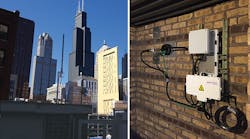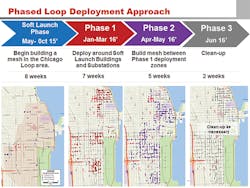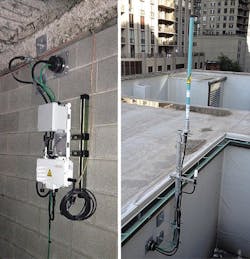AMI Deployment Reaches New Heights
The central business district in Chicago, Illinois, U.S., is a dense, concrete jungle made up of thousands of concrete buildings, some of which stretch high enough into the sky to create concrete valleys for pedestrians below. Often referred to as the Loop, this 4-sq-mile (10-sq-km) area is recognized as the second-largest central business district in the U.S. (next to Manhattan in New York City) and features hundreds of high-rise buildings — some built in the 1800s — for residential and commercial use.
Achieving effective cell phone or radio coverage in areas of the Loop can prove challenging. This was the challenge for Commonwealth Edison Co. (ComEd) in 2016 when it began installing smart meters in Loop-area high-rise buildings.
How does a utility create an infrastructure that enables nearly 100,000 smart meters to communicate with its advanced metering infrastructure (AMI) on behalf of customers? And how does it successfully achieve this when no template or process exists to identify and address potential issues for a dense urban environment? ComEd had to answer these questions as it defined its strategy for installing smart meters in the Loop.
ComEd’s Chicago Loop strategy included deployment of nearly 100,000 smart meters at more than 2000 high-rise buildings.
Soft Launch
Prior to deploying smart meters in Chicago’s Loop area, ComEd developed a soft-launch plan that began in early 2015. The soft launch gave the utility an opportunity to test its meter deployment processes and network radio connectivity in a sampling of Loop-area buildings. The plan involved the installation of smart meters in 31 Loop-area buildings, followed by installations in another 2000 buildings by June 2016.
A cross-functional team was established to build and execute the Loop plan. The team included representation from ComEd’s AMI deployment, AMI information technology network, AMI operations, distribution engineering standards, meter engineering standards and external affairs/large customer solutions groups, along with representatives from Silver Spring Networks, which provided the technology for ComEd’s smart grid project.
Among the first buildings to receive smart meters was Chicago’s Presidential Towers, a set of four buildings with a total of more than 2300 meters. To ensure a premier customer experience with tenants in the building, an education booth was set up in the building lobbies, and ComEd representatives attempted to knock on the doors of every unit in the buildings and leave a door hanger to confirm smart meter installation had been completed. The team completed all installations in two days, which was two days sooner than planned.
The success of the soft launch provided ComEd a number of benefits: a better understanding of how to educate customers, what preparations were necessary for the exchange of meters, how to execute AMI exchanges efficiently and effectively, and how radio propagation penetrates within and between some types of high-rise construction methods.
ComEd’s Chicago Loop strategy included deployment of nearly 100,000 smart meters, similar to that above, across more than 2000 high-rise buildings.
Full Deployment
The soft launch provided ComEd with small networks of smart meters within the high-rise area that communicated with the rest of ComEd’s AMI network. However, these networks were not enough to ensure ComEd would achieve communication with every smart meter required in the high-traffic central business district.
Because customer satisfaction is a high priority for ComEd, the utility needed a plan to maintain the level of service its customers had come to expect while addressing the following issues:
- A communications infrastructure to replace the building of distribution poles with access points (APs) — or devices that help to facilitate communication from smart meters to the ComEd network — and tools to install APs and take line-side power (not customer power)
- Solutions to enable successful smart meter communications within, through and outside 2000 varieties of buildings in Chicago’s Loop
- A way to assess effectively how well the smart meters communicate in every building
- A minimized number of APs and Silver Spring MicroAPs to manage both ongoing costs and the amount of capital needed in full deployment to develop and maintain the AMI network
- An ability to deploy approximately 87,000 smart meters within a six- to nine-month installation window as well as a triage process to identify and quickly correct smart meters that did not communicate with the network.
ComEd met these challenges with a one-of-a-kind solution: installing APs at six of its substations within the Loop high-rise area. Each substation was strategically identified across the Loop so they were, to the extent possible, equally spaced across the affected high-rise area. Antennas were placed on substation rooftops where APs were installed.
These substations, together with the small networks of communicating smart meters within the high-rise areas, created a base communications network that enabled ComEd to start smart meter deployment. From these base locations, ComEd’s meter deployment team looked at installing smart meters within high-rise buildings in the immediate vicinity of each base location, starting closest to the base stations and moving out radially.
Central to the success of ComEd’s smart meter deployment plan was early education and outreach to the manager of every high-rise building in the Loop area. Each building was treated as a community, and building management was viewed as the equivalent to municipal leadership of that community. This close partnership with building management ensured optimal tenant communication and enabled incorporation of building-management feedback.
Access point and antenna installed at ComEd’s Ontario substation.
Walk-Down Process
Because more than 2000 buildings make up the Loop high-rise area in Chicago, it was impractical for ComEd crews to test communication coverage before and after every smart meter was installed. Instead, the utility tested communications at buildings with 250 meters or more installed prior to exchanging the smart meters.
During these walk downs, which were arranged with the cooperation of building managers, ComEd reviewed how well newly installed meters might communicate within the building and, when necessary, determined what network solutions were needed to ensure radio communication from the smart meters within the building once they were installed.
To help building managers understand the process, ComEd’s deployment team contacted building and property managers to inform them of the upcoming installation of smart meters in their buildings. This also provided the deployment team with an opportunity to discuss the benefits of smart meters for tenants and high-rise management as well as to describe the upcoming walk-down process. After confirming an appointment for a walk down, an email was sent to the property manager as another reminder.
On the day of the walk down, the ComEd team arrived on the premises to take notes of the meter room location and condition, and conduct a communications analysis to ensure all meters would communicate during the meter exchanges at the time of the appointment.
A list of building details could include notes and pictures on the presence of dogs, parking options (available on premise or in the surrounding area), occupancy makeup (for example, senior or student living, or commercial tenants), and if there were any conjoining premises with different addresses whose meters may be in the same locations as the high-rise building meters.
At the end of the walk down, the work planner met with the property manager or chief engineer to share the results of the walk down and discuss the planned meter exchange time frame. During most visits, appointments were scheduled on site. The work planner left the property manager with a custom mark-your-calendar appointment business card and requested business cards from the building contacts. This information was used to generate appointment confirmation emails and appointment reminder emails (48 hours prior to the appointment date) as well as provided immediate contacts in the event more information was needed.
Site-Specific Designs
ComEd also used the information to develop property fact sheets, which were leveraged to create a deployment design for each building. This design was the key factor in executing a successful plan during the deployment meter exchange appointment. The design would determine the number of days needed to exchange all meters, the number of installers required to complete the meter exchanges, whether support would be needed from other departments during the appointment, as well as special resources, parking and staging options, and network design communications instructions.
The importance of a well-designed plan helped to ensure everyone involved in the meter exchange process had the same information on building objectives and how the installation process would be accomplished.
ComEd’s deployment strategy for Loop-area high-rise buildings was to complete each building in its entirety during an appointment. To do this, the ComEd work planner worked closely with the ComEd field supervisor to confirm all necessary resources would be available from building, installer and network perspectives (that is, the installer’s attendance, meter inventory, transport and parking solutions). If the building had a meter count greater than 500 meters, the building was staged one day prior to the appointment.
This staging process consisted of ComEd employees arriving at the building to prepare the meter closets for the arrival of the installer on the following day. Meter closets were stocked with the required number of smart meters needed for each closet exchange, exchange stickers were placed on meter banks, and areas around meter banks were reviewed to ensure the installers could complete the exchanges safely.
On the day of the appointment, ComEd installers were briefed by their field supervisors on the details of the building in which they were assigned. For larger projects, installers were sometimes transported as a team by bus. Once on site, the installer began working on the highest floor assigned to them. During the exchange, legacy meters were placed in the meter boxes from which the new smart meters were delivered. ComEd employees then followed behind the installer to remove the legacy meters and clean up the meter room. In this way, the process of meter installation proceeded as efficiently as possible.
When a meter closet installation was complete, the installer would secure the meter closet and report to the next assigned floor. The same process continued throughout the building until the deployment was completed in its entirety. Before exiting the building, a supervisor or installer would check the doors of all meter closets to ensure they were locked and secured before the ComEd team left the premise.
ComEd developed a collection of property fact sheets to ensure the successful installation of smart meters in more than 2000 high-rise buildings.
Communications Solutions
When the walk-down analysis showed solutions would be necessary to aid in the communications of a building’s smart meters, ComEd’s meter standards team developed one-of-a-kind standards and tools that enabled APs and MicroAPs (meters that serve a dual purpose as small APs) to be installed within buildings and take line-side (non-metered) power. Examples included adapter sleeves placed in the meter sockets and meters placed on top of the sleeves, which had a power cord extending from them to power the APs; hardwiring the power connection within transformer-rated meters; and passive meter sockets used to power MicroAPs.
ComEd also used meter patch antenna couplers, which enabled the installation of a secondary antenna on a meter to improve communication in hard-to-reach locations, such as metal enclosures, meter rooms or meters located in isolated areas. ComEd used this tool to extend the communications reach of its smart meters within high-rise buildings. The tool involved using conductive tape to attach an antenna to the meter’s glass or plastic cover. From this tape, ComEd attached coaxial cable, which extended to an outside hallway or room, to a small salt-shaker-sized antenna to facilitate communications.
When any of these options were necessary, ComEd discussed them with the building managers and kept them informed as solutions were developed. Going forward, ComEd used the knowledge gathered through the walk-down and deployment processes to develop standards for new structures being built in the utility’s downtown area. These standards provided developers with installation and construction guidance for designing indoor electric meter rooms that would ensure an efficient and effective communications network.
These requirements addressed below-grade and multiple above-grade meter rooms to ensure the successful installation of ComEd smart meters and a good experience for both building managers and tenants. Provisions were designed for both commercial and residential buildings, as well as single, multiple and indoor meter rooms to ensure successful communication access and performance.
In the end, ComEd’s first-of-its-kind solution helped to provide premier customer service by ensuring the timely installation of smart meters in Chicago’s Loop high-rise buildings, effective communication across thousands of buildings, and outreach and education to building managers.
Acknowledgement
The authors would like to thank ComEd’s Tom Dominguez, senior marketing specialist, marketing; Chris Gubala, senior engineer, system metering standards; and Susie Hoftiezer, manager, AMI deployment, for their contributions to this article.
Schereina Howton is an advanced metering infrastructure deployment business analyst responsible for planning and deployment of smart meters throughout Commonwealth Edison’s service area. As project manager, Howton planned the deployment of smart meters in the Chicago Loop Business District. Howton has a master’s degree in accounting, is Lean Six Sigma Yellow Belt certified and is enrolled in the PMP certification program at DeVry University. Howton and Collins are valued contributors to the Innovation Award-winning Breaking RF Barriers team.
Chris Collins, an Exelon Corp. project manager, is responsible for engineering and deployment of smart grid network infrastructures at BGE (distribution automation) and Commonwealth Edison (advanced metering infrastructure and distribution automation). In 27 years with ComEd and Exelon, Collins managed numerous telecom platform deployment projects, Exelon’s network operations — including data, firewall, fiber, synchronous optical networking and voice systems — and was an electrical engineer at Exelon’s Dresden nuclear station and nuclear corporate offices. Collins holds a BSEE degree and a master’s degree in telecommunications, and is PMP certified.






